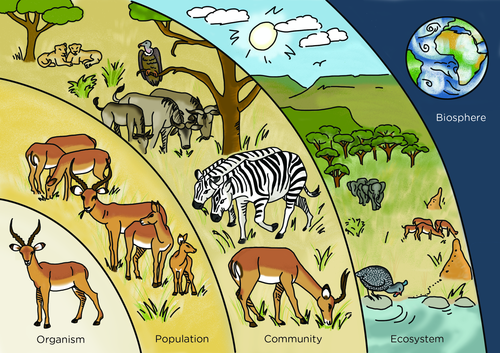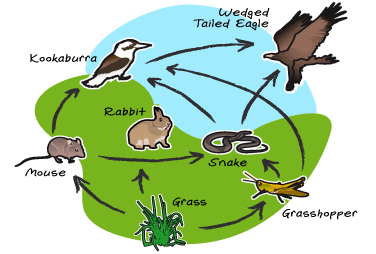Organisms and Population
Table of Content |
 Definition of Organisms
Definition of Organisms
“An Organism is a contiguous living system, such as plants, animals, fungus, bacterium or archaeon.” In other words, organisms are any living entity like plant, human or any other living thing that lives in an environment has the capability to adapt and possess certain structure and behavior.
Example of Organisms
Examples of organism are plants, animals and bacteria.
How do Organisms live in their Environment?
 All the organisms have the ability to adapt via the process of biological variation in order to adjust with their environment. It is adaptation that enhances the ability and chances of survival. Adaptation vary among species but has the common objective i.e. adjustment to variation. For example, polar bears possess several key characteristics and traits that make them capable of adjusting with the harsh conditions of life in Antarctica. They have dense fur coats that serve as protection from predators. Added to this, they have thick layers of fur to protect them from cold winds, followed by a waxy coat that helps in repelling water and keep their body warm. Thus, it can be said that the body of polar bears are well adapted to survive in cool weather.
All the organisms have the ability to adapt via the process of biological variation in order to adjust with their environment. It is adaptation that enhances the ability and chances of survival. Adaptation vary among species but has the common objective i.e. adjustment to variation. For example, polar bears possess several key characteristics and traits that make them capable of adjusting with the harsh conditions of life in Antarctica. They have dense fur coats that serve as protection from predators. Added to this, they have thick layers of fur to protect them from cold winds, followed by a waxy coat that helps in repelling water and keep their body warm. Thus, it can be said that the body of polar bears are well adapted to survive in cool weather.
Following figure shows inter-relationship between organism, population, community, ecosystem and the entire biosphere. An organism is the single living entity which collectively forms population. The population of different living organisms’ forms community and a community operates in an ecosystem, which comprise of both biotic and abiotic factors.
Definition of Population
The word Population is defined as “Group of individuals of any species that live in a well–defined geographical area, share or compete for similar resources and interbreed.” In other words, population is the summation of all the organisms of the particular species, in a particular geographical area, at the specific time with the capability of interbreeding.
Example of Population
A population of small ants in any particular field or a population of males between the age 30 – 50 years in a specific city.
Population Attributes
-
A population has several attributes like birth rate, death rate, population density and sex ratio.
-
A population is composed of individuals of several age groups at any given period.
-
The size of the population is called as Population Density. It indicates the total number of individuals in a particular niche.
Population Growth
The size of any population changes continuously and this change depends on several factors such as weather, availability of food, competition, pressure of predator, etc. Thus, the density of population changes due to four processes, i.e. Mortality (M), Natality (N), Emigration (E) and Immigration (I).
Following figure shows the formation of biosphere. “A biosphere refers to the region of the surface and atmosphere of the earth occupied by living organisms.” An organism is the basic entity of biosphere; these organisms have a population density in an area. When the population of different organisms interacts with each other in a specific area, it is referred as community. The community operates in an environment with several factors in specific flora and fauna and is called ecosystem. This way, entire biosphere is formed and it is as important as life. Without it, our planet will be lifeless.
Figure: Formation of Biosphere
Frequently Asked Questions
Q1. What are Biotic and Abiotic Factors of Living Organisms?
Sol. Abiotic Factors are nonliving factors that affect the organisms such as moisture, temperature, sunlight, humidity, precipitation and water chemistry. These factors have significant impact on survival and reproduction of an organism. Following figure shows some of the abiotic factors affecting an organism such as air, wind, light, gases, temperature, light and water.
Figure: Abiotic Factors
 On the other hand, Biotic Factors include all the living organisms in ecosystem, followed by their interactions and their waster products. Some organisms eat plants and animals while some produce their own food. Added to this, there are several organisms that feed on decaying matter. Following figure shows the biotic factors. Here, grasshopper feed on grass, snake feed on grass hoppers, and eagle feed snake. In other food chain, mouse feeds grass, and these mice are eaten by Kookaburra which is ultimately eaten by wedged tailed eagle. Thus, our ecosystem is comprised of several interlinked food chains.
On the other hand, Biotic Factors include all the living organisms in ecosystem, followed by their interactions and their waster products. Some organisms eat plants and animals while some produce their own food. Added to this, there are several organisms that feed on decaying matter. Following figure shows the biotic factors. Here, grasshopper feed on grass, snake feed on grass hoppers, and eagle feed snake. In other food chain, mouse feeds grass, and these mice are eaten by Kookaburra which is ultimately eaten by wedged tailed eagle. Thus, our ecosystem is comprised of several interlinked food chains.
Q2. What are the strategies to adapt to abiotic factors?
Sol. Organisms, in order sustain try to maintain internal environment by four strategies:
1. Regulate – Several animals have the ability to regulate their body temperature and this helps in adjusting with the changes in temperature. For example, in summers our body regulates temperature by sweating and in winters, we shiver as shivering produces heat.
2. Conform – There are several animals who are not able to regulate their body temperature according to outside temperature. Such organisms are called as conformers. These conformers have not evolved; rather they have become regulators because regulation is energetically expensive.
3. Migrate – This is another method of adaptation, whereby organisms migrate to the favorable conditions from unfavorable. For example, birds often migrate from cold regions to relatively warmer places and vice versa.
4. Suspend – Some organisms suspend cease to be metabolically active and enter in a period of dormancy. For example, reptiles enter into hibernation during cold season and are active again in summers.
Watch this Video for more reference

